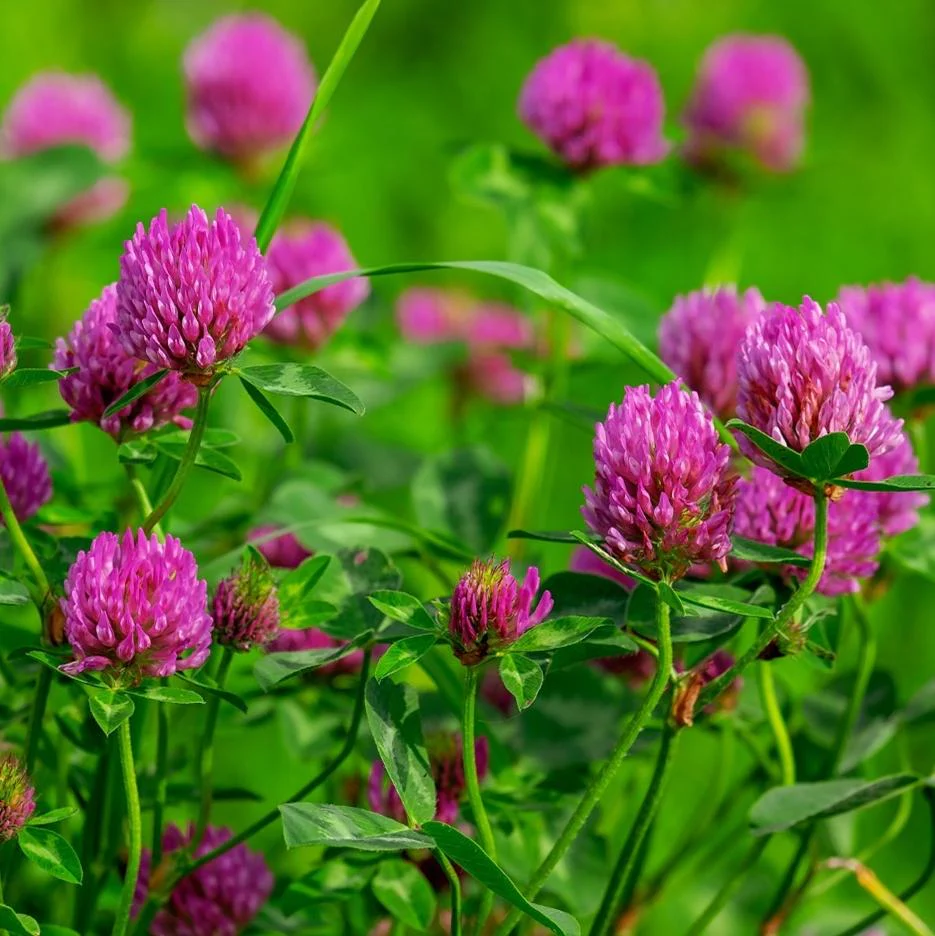Trifolium pratense (Red clover)

The clover (Trifolium) family is cultivated all over the world, and its members are used in the food, pharmaceutical, and cosmetics industries. Different parts of this plant contain essential minerals (P, Mg, Cr, K, Ca, Na, and Fe) that, along with other compounds, can regulate many molecular pathways and biological processes, especially the immune system (McKenna et al., 2018).
Menopause:
Analysis of red clover extract confirmed the presence of compounds such as phytoestrogens like cinnamic acid, 3-O-(Z)-pcoumaroylquinic acid, epigallocatechin, caffeic acid, quercetin-3,7-diglucoside, kaempferol-3,7-di-O-glucoside, myricetin-3-Orhamnoside, fraxidin, vitexin-O-(maloyl) rhamnoside, formononetin, genistein, biochanin A-7-glucoside, daidzein 7-O-D-glucoside, and apigenin-7-O-glucoside (Akbaribazm et al., 2020c). The phytoestrogenic compounds of red clover simulate the production of hormones in the female body and decrease the severity and frequency of menopausal symptoms by binding to ERβ (Hidalgo et al., 2005; Salimpour et al., 2007).
In a randomized and placebo-controlled trial, 190 postmenopausal women were treated with red clover extract (28.6 mg kg-1 day-1) over 90 days, which insignificantly reduced the symptoms of depression and anxiety and improved hair loss and skin characteristics in these women compared to the placebo group (Tice et al., 2003). In a prospective, randomized, double-blinded, placebo-controlled trial by Del Giorno et al. (2010), 40 mg/kg of red clover over a 12-month period did not significantly improve menopausal symptoms and sexual desire in 120 women with menopausal symptoms aged 45–65 years (Del Giorno et al., 2010).
In another randomized, double-blinded, placebo-controlled trial, hormonal levels and endometrial thickness improved, and hot flushes reduced by 44% in 30 postmenopausal women treated with 80 mg/kg red clover extract for more than 12 months as compared with the placebo group (van de Weijer & Barentsen, 2002).
An alternative for HRP (Hormone Replacement Therapy?
Red clover extract (375 and 750 μg/g) after 21 days increased the weight of the uterus (via binding to Erα), and through binding to ERβ, increased mammary gland development and plasma prolactin level, and decreased bone loss in ovariectomized rats (Santell et al., 1997). The doses of 200 and 400 mg/kg of red clover hydroalcoholic extract suppressed the proliferation of triple-negative breast tumor cells and their metastasis to the lung and brain in 4T1 tumor-bearing Balb/c mice after 35 days, partly via activating the ERα signaling pathway, decreasing 17 β-estradiol levels, and modulating apoptosis-related pathways (Akbaribazm et al., 2020b; Akbaribazm et al., 2020a).
Infertility:
In an in vitro study, the endometrial glandular cells were isolated from five premenopausal and nonpregnant women whose endometrium was in the proliferative phase, and the cells were incubated with red clover extract, which significantly decreased ER-α and increased ER-β mRNA expressions and also suppressed the secretion of cytokines such as TNF-α and IL-1α. These results suggested that the expression of ER-α/β in endometrial glandular cells might be regulated by phytoestrogens at the mRNA and protein levels (Staar et al., 2005). In addition, in a study by Lian et al. on animal models (2001), a single subcutaneous administration of genistein (1 mg/30 g body weight) in short-term (2 weeks) and daidzein (1 mg/30 g body weight) in long-term (30 weeks) inhibited the expression of estrogen-dependent genes (c-fos and c-jun) and suppressed IL-lα and TNF-α cytokines through cytokine- and estrogen receptor-mediated pathways, which are important in the proliferation and differentiation of endometrial cells (Lian et al., 2001).